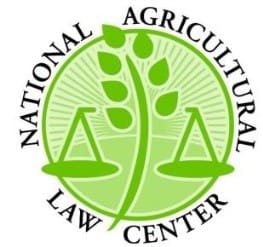A comprehensive summary of today’s judicial, legislative, and regulatory developments in agriculture and food. Email important additions HERE.
ANNOUNCEMENT: Mark your calendar for the next Agricultural & Food Law Consortium webinar, Tuesday, January 16th: “The New Deal: Understanding and Negotiating Dairy Supply Contracts.” Details available here.
JUDICIAL: Includes nutrition programs, bankruptcy, and urb & ag issues.
In KAWRAN BAZAR, INC., MOHAMMAD ELIAS KHAN, Plaintiffs-Appellants, v. UNITED STATES OF AMERICA, SECRETARY SONNY PERDUE, Defendants-Appellees, 17-61-cv, 2017 WL 6508824 (2nd Cir. December 20, 2017), a grocery store owner appealed his six-year disqualification from the Supplemental Nutrition Assistance Program (SNAP) for violating New York State’s Special Supplemental Nutrition Program for Women, Infants and Children (WIC). On appeal, plaintiff argued his store qualifies for the “hardship exception” because halal meat is a “staple food” and Muslim SNAP recipients “would suffer hardship from the store’s disqualification because no other local store sells halal food.” Evidence suggested, however, that “16 stores within a one-mile radius supplied as large a variety of staple foods at comparable prices.” Affirmed for defendants.
In UNITED STATES of America, Plaintiff, v. Maureen Denise MCOUAT, Defendant, NO: 5:16-CV-691-BR, 2017 WL 6503617 (E.D.N.C. December 19, 2017), defendant obtained a loan from Farm Service Agency (FSA) to purchase a farm and defaulted on the loan. Bankruptcy court granted defendant’s motion to avoid the lien, and government filed suit “to recover statutory damages and civil penalties under the False Claims Act.” Defendant filed motion for directed reference to bankruptcy court, arguing “it is a core proceeding ‘related to’ a Title 11 case.” Appellate court reasoned that “[t]he government could not have brought its claims during the contested matter proceeding in the bankruptcy court. These claims would have been counterclaims . . .not suited for the informal procedures of a contested matter and would have been procedurally inappropriate.” Defendant’s motion denied.
In ECOPLEXUS INC., Fresh Air Energy II, LLC and Currituck Sunshine Farm, LLC, Petitioners, v. COUNTY OF CURRITUCK, BOARD OF COMMISSIONERS, and David L. Griggs, in his official capacity as Chairman of the Board of Commissioners, and O.Vance Aydlett, Jr., S. Paul O’Neal, Mike D. Hall, Mike H. Payment, Paul M. Beaumont, and Marion Gilbert, in their official capacities as members of the Board of Commissioners of the County of Currituck, Respondents, And Steven P. Fentress, Donald Leon Proffitt, Gail Lynn Proffitt, James J. Wierzbicki, Margaret Geraldine Newsome, David L. Rice, Linda L. Rice, Randy L. Mills, Roy W. Tate, Kathy C. Tate, Fidel C. Escobar, Laura Darden and Michelle Lynn Cunningham, Intervenor-Respondents, No. COA17-656, 2017 WL 6455420 (N.C. Ct. App. December 19, 2017), plaintiff appealed denial by Board of Commissioners of a conditional use permit to construct a solar array farm on a former golf course. Board’s denial was based, in part, on a witness’ opinion that solar farms “are an industrial use, in contradiction to the Currituck County UDO specifically designating solar arrays as an appropriate and permitted use in agricultural areas, subject to a use permit.” Appellate court reasoned that “[g]eneral assertions criticizing solar farms by lay witnesses do not rise to the level of competent, material, and substantial evidence.” Board decision reversed and remanded.
REGULATORY: Includes AMS, EPA, FWS, FDA, and NOAA rules and notices.
AGRICULTURAL MARKETING SERVICE:
Rule would implement a recommendation from the Cherry Industry Administrative Board to revise the exemption provisions under the Marketing Order for tart cherries. Info here.
Rule seeks comments on a recommendation to establish free and restricted percentages for the 2017-18 crop year under the marketing order for cranberries grown in the production area. Details here.
ENVIRONMENTAL PROTECTION AGENCY: Rule establishes an exemption from the requirement of a tolerance for residues of phenylethyl acetate when used as an inert ingredient at a maximum of 0.015% in pesticide formulations applied to growing crops and raw agricultural commodities after harvest. Details here.
FISH AND WILDLIFE SERVICE: Notice FWS is initiating a 5-year status review of the Alaska-breeding population of Steller’s eider under the Endangered Species Act. Details here.
FOOD AND DRUG ADMINISTRATION: Rule FDA is amending the regulations for food additives permitted in feed and drinking water of animals to provide for the safe use of formic acid as a feed acidifying agent in complete poultry feeds. Info here.
NATIONAL OCEANIC AND ATMOSPHERIC ADMINISTRATION: Rule NOAA implements interim measures to reduce overfishing of golden tilefish in Federal waters of the South Atlantic. Info here.
